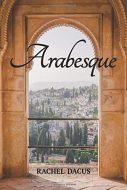 Rachel Dacus
Rachel Dacus
Arabesque
FutureCycle Press
Reviewer: Maria Rouphail
Rachel Dacus’s Arabesque brings to mind the old maxim, ut pictura poesis (“as in painting, so in poetry”). Formulated by Horace as something of a touchstone for evaluating the arts, the analogy was invoked rather unsystematically in later Western art and poetry. It also came to suggest a kind of complementarity among aesthetic forms—that what is created on the page can be translated in some way, more or less, onto the canvas. In a similar way, ekphrastic poetry references or quotes works of visual art. Think Homer’s shield of Achilles, or Auden’s “Musée des Beaux Artes.”
Never confined solely to painting and poetry, the idea of aesthetic reciprocity today encompasses multiple genres. Search the term “dance poetry,” and scores of examples pop up, among them the iconic “My Papa’s Waltz,” wherein Roethke, as many have recognized, echoes the triple-time rhythm of the dance:
We romped until the pans
Slid from the kitchen shelf;
My mother’s countenance
Could not unfrown itself.[i]
Rita Dove recently observed that her own work displays a “musical mimicry,” and that “poetry is […] a kind of dance.”[ii] She adds, “Just as the dancer is limited by gravity and the capabilities of the body, poetic expression is continually restrained by the dimensions of the page, the capacity of the lungs, and the very architecture of language.”[iii]
Which brings us directly to Dacus and Arabesque. The term itself belongs to visual art and to dance. It is a form of “surface decorations based on rhythmic linear patterns of scrolling and interlacing foliage, tendrils, or plain lines.[iv] And: “a position in ballet in which the dancer stands on one leg with the other leg held out straight behind.”[v]
In her epigraph to Arabesque, Rachel Dacus refers to words themselves, their very letters, as “those arabesques on a page.” In another epigraph belonging to the eponymous poem, “Arabesque,” Dacus defines the term as both ornament and the bella figura of the choreographed body.
What the definitions share in common is their reference to artifice, to nothing straightforward; that which is recursive but static, difficult to achieve but also graceful and lovely to behold.
But what are we to make of “arabesque” as regarding poetry? Should we think of the decorative arts? An artificial dance pose that stretches the body with spectacular visual effect? Or, Rita Dove’s perceptive analogy of dance and poetry? Again, “Arabesque,” Dacus’s signature trope offers some guidance:
Precariousness. Shoulder it. Take up
the position like a cross. Ask yourself
what it’s been about and come down
into that solid pillar of your own leg
under your arched body.
A life in the arts is notoriously unpredictable. The riskiest way is perhaps that of the dancer, whose very body is both instrument and ephemeral text. Perfection comes through punishing physical exercise; ambition is “born in the mother lap of endurance.” A dancer must “Secure [her] inner strength like a pole on which to hang a life’s work.” Even so, there are no guarantees that relentless practice (much less, uncompromising desire) will produce perfection. Precariousness, indeed.
Ambition and hard work belong to the writer’s way, too, whereby “[life] becomes a Bernini-twist of bodies / in motion, and emotion arabesques / through pen and pain.” According to this formulation, dance and poetry must be sister arts whose common DNA is something Dacus calls “likeness”:
Likeness is our essential speech.
Shapes echo others. The eye is a leaf
and its own tear. A praying mantis
profiles a priest. Cloud coil,
and we are all walking texts
waiting to be read.
The slippery fact of ut pictura poesis, though, is that despite their complementarity, the various media are not interchangeable formal objects. “Likeness” must ultimately reside in the subjective self who creates art. It comes down to desire and striving for mastery with and against the formal limits of art. Here, Dacus and Dove may be in tacit agreement.
In addition to “Arabesque,” there are a number of provocative poems in the collection.
“Wine Under a Fig Tree” evokes life’s vexatious randomness. Dacus brings fresh invention to this conventional idea, as well as to a timeless image. What does the fig tree teach us?
That any tiny winged thing
may explode from you without warning…
The next statement will resonate with any creator who has worked every muscle and nerve to make worthy art, only for the effort to come to naught:
How your life’s work can be picked, peeled,
and sautéed, can glisten dark and lobed
in someone else’s pan.
We certainly know how this life feels, whatever our medium.
“The Buried Part” is darkly archetypal. This poem moves solemnly through psychological terrain of great emotional significance:
Why did I think of an underground river
with its secret torrent heart
at the sound of the word Mother?
…
How can I admit
I don’t want my life smothered
under the weight of another,
the way she wilted under shouldering
the tonnage of a woman’s life.
The speaker, remembering a photograph and contemplating motherhood herself, wants answers to questions that can bring only scant resolution or none at all:
How can I ask her now
about the picture of me, three days old
in her limp arms, find out what ice
was forming under the pall on her wrung face?
This strong poem might have done well to conclude with that starkly powerful statement.
“Bird Bones” is clear, crisp, and poignant:
Bird bones are hollow, you know,
as light as life.
And:
My book will contain his arched wings
spread on the soil like a striped cloak
and his pale yellow beak, which opened once
and closed as he died, clearly calling Ba-ba!
piping through the bones of memory.
Dacus displays fine control of the traditional image of the bird/poet, making the goldfinch a personal emblem. A number of the poems in Arabesque demonstrate this caliber of art.
[i] https://www.poetryfoundation.org/poems/43330/my-papas-waltz
[ii] https://www.eurozine.com/poetry-is-a-kind-of-dance/
[iii] https://www.eurozine.com/poetry-is-a-kind-of-dance/
[iv] Fleming, John; Honour, Hugh. Dictionary of the Decorative Arts. Penguin, 1977. Cited
in https://en.wikipedia.org/wiki/Arabesque.
[v] https://ballethub.com/ballet-term/arabesque/

